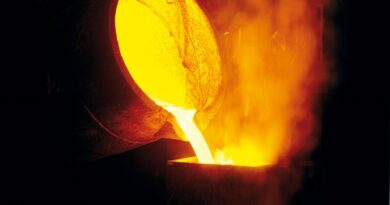REFRACTORIES: Fused alumina and bauxite prices rise in June and July
Roskill says prices for Chinese refractory bauxite increased by 1.5% between May and July to reach US$425-455/t (FOB Xingang, 85-88% Al2O3 grade, as reported by FastMarkets). Prices had previously risen strongly in late 2020 and early 2021 on tight supply, peaking in January/February as environmental closures coincided with shipping disruption, just as international markets were recovering and ramping up.
The markets for both bauxite and alumina have experienced disruption of supply chains in recent years. Calcined bauxite was primarily sourced from China with Guyana, formerly the main source a distant second and other volumes from Brazil and India.
As Chinese supply subsequently reopened and shipping disruptions eased into Q2, prices fell from March. Meanwhile, prices for white fused (99% Al2O3) and brown fused (95% Al2O3) alumina have continued to rise though H1 2021, with prices reaching US$659/t and US$724/t (FOB, 1-3mm, as reported by Asian Metal) in July for these grades, a rise of 8% for both since January.
Plant closures and environmental inspections in China continue to threaten the refractory industry, causing issues throughout the raw material supply chain for non-metallurgical bauxite, alumina and graphite.
Winter closures in late 2020/early 2021 were stricter than usual with production levels lower than expected. New rounds of inspections were brought in from March, associated with the roll out of the new national pollutant discharge permit system and focussed on industrial centres in the provinces of Anhui, Guangxi, Henan, Hunan, Jiangxi, Liaoning, Shanxi and Yunnan.
Bauxite production in China is centred on Shanxi, Henan and Guizhou, but inspections had a limited impact on the industry through most of the year. However, annual winter closures are expected to hit again in late-2021 when prices could rise further.
This restricted supply and caused prices to rise, at a time when demand from the refractories industry was strong. Additional supply from Guyana and to an extent from India and Brazil has been insufficient to replace the lost supply from China.
Alumina supply experienced significant disruption in 2018, with wide fluctuations in spot pricing, although most non-metallurgical trades are based on annual or longer term contracts.
The forced 50% reduction in output from the Alunorte operation in Brazil caused particular tightness in the ATH market in North America, which had become increasingly reliant on imports following the closure of two plants and alternative sources were sought to satisfy demand.
The threat of US sanctions against Rusal and a prolonged strike at some Australian alumina operations also contributed to widely fluctuating spot prices for alumina and restricted supply.
The supply problems are expected to have been largely resolved and outlook will be assessed in the Roskill report.




